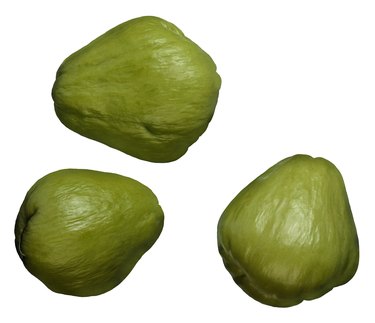 Look for chayotes with smooth, unblemished skin. Image Credit: Brand X Pictures/Stockbyte/Getty Images
Look for chayotes with smooth, unblemished skin. Image Credit: Brand X Pictures/Stockbyte/Getty Images
The chayote — pronounced "chy-OH-tay" — is a tropical squash that resembles a pear. It has a subtle flavor, like that of a cucumber, with hints of sweetness reminiscent of an apple, but it is typically prepared like a summer squash. While chayote is often cooked, its mild, versatile flavor and crisp texture add lovely touches to garden greens or fruit salads. Look for small, firm chayotes with tender skins when you want to serve them raw.
Video of the Day
Selection and Storage
Chayote vary in size and appearance. Those found in the United States are usually pale green in color with smooth, slightly crinkled-looking skin and are about the size of an avocado. Some chayote may be covered with prickles that can be removed with gentle scrubbing. When purchasing them to consume raw, look for small chayotes that are heavy for their size. The harder the flesh, the better the flavor. Select chayote that are very firm, so their crisp texture lends a crunch to the dish you are preparing. Store chayotes at room temperature for two weeks and in the refrigerator for four to six weeks.
Chayote Snacks
Raw chayote makes a great snack on its own, served with condiments or tossed with seasonings. Cut chayote in half like you would an avocado and remove the seed. The seed can be eaten and has a pleasant, nutty flavor when cooked. Cube, slice or julienne the chayote. Serve it alone or with butter or cream. Liven up the flavor by tossing it with lime juice, and add a touch of cayenne pepper to give it a spicy kick. Coat with sweet seasonings, such as sugar or brown sugar, and snack on it dessert-style.
Chayote Salads
The mild flavor and crisp texture of chayote complement salads. Thinly slice or cube chayote and add it to garden salads. Julienne chayote and add it to coleslaw for additional flavor and crunch. Change up a cucumber-dill vinaigrette salad by incorporating or replacing the cukes with chayote. Because chayotes have hints of sweetness, go ahead and add them to fresh fruit salads.
A Word of Caution
While smaller chayotes tend to have soft skin that may be consumed, some prefer to remove it first. Chayote skin is easily removed with a vegetable peeler or paring knife, but doing so releases a sticky sap that may cause skin irritation and numbness. Wear rubber gloves when peeling chayote to avoid exposure to the sap. Rinse the chayote thoroughly under running water to remove excess sap. The irritation and numbness caused by chayote sap has no lasting consequences but can be unpleasant.



























